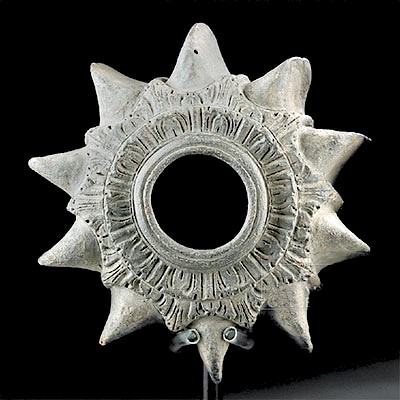Huge Jalisco Standing Guardian Figure
Lot 55c
About Seller
Artemis Fine Arts
686 S Taylor Ave, Ste 106
Louisville, CO 80027
United States
Selling antiquities, ancient and ethnographic art online since 1993, Artemis Gallery specializes in Classical Antiquities (Egyptian, Greek, Roman, Near Eastern), Asian, Pre-Columbian, African / Tribal / Oceanographic art. Our extensive inventory includes pottery, stone, metal, wood, glass and textil...Read more
Estimate:
$6,500 - $9,750
Absentee vs Live bid
Two ways to bid:
- Leave a max absentee bid and the platform will bid on your behalf up to your maximum bid during the live auction.
- Bid live during the auction and your bids will be submitted real-time to the auctioneer.
Bid Increments
| Price | Bid Increment |
|---|---|
| $0 | $25 |
| $300 | $50 |
| $1,000 | $100 |
| $2,000 | $250 |
| $5,000 | $500 |
| $10,000 | $1,000 |
| $20,000 | $2,500 |
| $50,000 | $5,000 |
| $100,000 | $10,000 |
| $200,000 | $20,000 |
About Auction
By Artemis Fine Arts
Jul 25, 2019
Set Reminder
2019-07-25 10:00:00
2019-07-25 10:00:00
America/New_York
Bidsquare
Bidsquare : Pre-Columbian | Tribal | Ethnographic
https://www.bidsquare.com/auctions/artemis-gallery/pre-columbian-tribal-ethnographic-4291
Featuring ancient and ethnographic art from around the world, including Pre-Columbian, Native American, African / Tribal, Ethnographic, Spanish Colonial, Fossils, Fine Art, much more. Many Oceanic pieces from an important Tucson, Arizona collection, first time at auction!! Artemis Fine Arts info@artemisfinearts.com
Featuring ancient and ethnographic art from around the world, including Pre-Columbian, Native American, African / Tribal, Ethnographic, Spanish Colonial, Fossils, Fine Art, much more. Many Oceanic pieces from an important Tucson, Arizona collection, first time at auction!! Artemis Fine Arts info@artemisfinearts.com
- Lot Description
Pre-Columbian, West Mexico, Jalisco, ca. 300 BCE to 300 CE. An incredible, huge earthenware guardian figure from the West Mexican shaft tomb culture. The artistry and detail of this piece speaks to the great importance that ancient Jaliscoans placed on furnishing the tombs of their kin. The figure is male, dressed in a manner that is often associated with male figures, including the horned helmet that probably signifies the role of a shaman. He stands with a club across his chest, gripped in both hands. He wears a cape over his left shoulder (which is a fantastic, free-hanging piece of clay that must have been very difficult to fire), has a belt with a dangling, celt-like item just below the belly button, and wears the two horned hat, which is painted with round, pale yellow geometric motifs. Huge ear spools and a nose ring complete the outfit. Size: 8.75" W x 17.7" H (22.2 cm x 45 cm)
Painted lines on the figure, done in that same pale yellow color, suggest tattoos or possibly scarification. The most prominent of these are around the neck and eyes. The figure has a large face, with huge, staring eyes that look slightly upward; the nose is well-sculpted and realistic, the mouth set in a grim, slightly-open line. The ears are large, and the shape of the skull inside the hat may suggest skull shaping, a common practice in the pre-Columbian New World that may have identified this figure as a member of a particular family.
West Mexican shaft tomb figures like this one derive their names from the central architectural feature that we know of from this culture. These people would build generally rectangular vertical shafts from the ground level down to narrow horizontal tunnels that led to one or more vaulted or rounded burial chambers. The geomorphology in the area means that these chambers are dug out of tepetate, a type of volcanic tuff material, which gives the chambers a rough-edged look. Although the dimensions of the chambers vary considerably, some only large enough to hold a single burial and its offerings, others seem designed to hold entire lineages. The placement of burial goods like this hollow figure was very similar. Grouped with other hollow figures, and alongside clay bowls, and boxes, they were positioned around the body (or bodies), near the skull. Unfortunately, we lack the information we would need to understand what these figures were made for - do they represent everyday people, even individuals? Are they religious? Were they created to mediate between the living and the dead? Whatever their purpose, today they are beautiful artwork and reminders of the mysterious past.
Provenance: private Guy Waters collection, Clearwater, Florida, USA, acquired over the last forty years
All items legal to buy/sell under U.S. Statute covering cultural patrimony Code 2600, CHAPTER 14, and are guaranteed to be as described or your money back.
A Certificate of Authenticity will accompany all winning bids.
We ship worldwide and handle all shipping in-house for your convenience.
#125063Excellent repairs and restoration with very small areas of overpainting along repair lines. Much original pigment remaining with caliche and manganese deposits on surface.Condition
- Shipping Info
-
All shipping is handled in-house for your convenience. Your invoice from Artemis Gallery will include shipping calculation instructions. If in doubt, please inquire BEFORE bidding for estimated shipping costs for individual items.
-
- Buyer's Premium



 EUR
EUR CAD
CAD AUD
AUD GBP
GBP MXN
MXN HKD
HKD CNY
CNY MYR
MYR SEK
SEK SGD
SGD CHF
CHF THB
THB

















